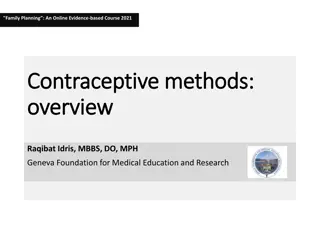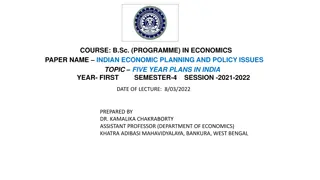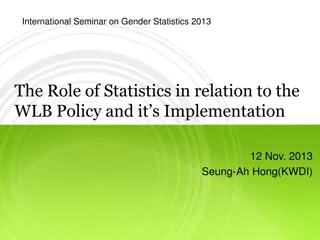The Impact of Family Planning Policies in India
In the mid-1960s, India initiated family planning policies to control population growth, with Sanjay Gandhi leading an aggressive sterilization campaign. The government imposed strict quotas, penalties, and incentives, resulting in millions of sterilizations. Despite initial support, the policy faced backlash, leading to its reversal after the 1977 elections. The long-term effects of these policies raise concerns about state intervention in reproductive choices and the lasting suspicion among the population. Population growth and its environmental impacts continue to be global challenges.
Download Presentation

Please find below an Image/Link to download the presentation.
The content on the website is provided AS IS for your information and personal use only. It may not be sold, licensed, or shared on other websites without obtaining consent from the author.If you encounter any issues during the download, it is possible that the publisher has removed the file from their server.
You are allowed to download the files provided on this website for personal or commercial use, subject to the condition that they are used lawfully. All files are the property of their respective owners.
The content on the website is provided AS IS for your information and personal use only. It may not be sold, licensed, or shared on other websites without obtaining consent from the author.
E N D
Presentation Transcript
POOR ECONOMICS 5 PAK SUDARNOS BIG FAMILY
History India had had a long history with family planning ,starting in the mid- 1960s. Sanjay Gandhi because all our industrial, economic , and agricultural progress would be no use if the population continued to rise at the present rate Although most politicians before him had identified population control as an important issue , Sanjay Gandhi brought to the problem to the both an unprecedented level of enthusiasm and the ability to twist as many arms as necessary to implement his chosen policies.
In April 1976 , the Indian Cabinet approved formal statement of national population policy that called for a number of measures to encourage family planning. financial incentive sterilizaion laws State were explicitly pressured to set sterilization quotas and fulfill them . The targets totaled 8.6 million sterilization for 1976-1977.
Failure to achieve monthly targets will not only result in the stoppage of salaries but also suspension and severest penalties . Parents of schoolchildren were visited by teachers , who told them that in the future ,their children may be denied enrollment in school if they did not agree to get sterilized. In 1976-1977 8.25 million people were reportedly sterilized,6.5million of them during just the period July-December 1976 . In 1977 India finally held elections , discussions of the sterilization policy were a key of the debate. The new government immediately reversed the policy.
In the longer term, Sanjay Gandhi actually contributed to the faster growth of Indian s population . However generalized suspicion of the motivations of the state seems to be one of the most durable residues of the Emergency; for example one still routinely hears of people in slums and villages refusing pulse polio drops because the believe it is a way to secretly sterilize children . 1990 85% of the population of the developing world lived in countries where the government had the explicit view the their population was too large and needed to be controlled through family planning.
There are certainly many reasons for the world at large to be worried about population growth today . The most obvious is tis potential impact on the environment .Drinking water is getting scarcer by the day in some parts of the world, in part directly because there are more people drinking and in part because having more people means growing more food and therefore using more water for irrigation.(70% of fresh water is accessed for irrigation) One fifth of the world s population lives in areas where fresh water is scarce.
The problem is that it is impossible to develop a reasonable population policy without understanding why some people have so many children ;Are they unable to control their own fertility, or is it a choice? And what are they reasons for those choice ?
WHAT IS WRONG WITH LARGE FAILIES Ethiopia Total fertility 6.12(fifty-one times than united states ) United states Total fertility rate is 2.05 Tomas Malthus believed that resource countries have are more or less fixed ,and he therefore thought that populations growth was bound to make them poorer.
Alwyn young The gift of the dying He argued that the epidemic would make future generations of Africans better off by reducing fertility. South Africa could be 5.6 percent richer in perpetuity as a direct consequence of HIV. We need to shift perspective , leave the large question aside, and focus n the lives and choices of poor people if we want to have any hope of making progress on this issue.
A small family is a happy family . Gary Becker A quality quantity tradeoff. That is , when there are more children , each of them will be of lower quality because the parents will devote fewer resources to feeding and schooling each of them properly. The found no evidence that children born in smaller families are really more educated. Large family size appears to have had no adverse effects on the education of children, even among Israeli Arabs , who are mostly very poor. The program led to a harp reduction in the number of children . By 1996 women in the program areas between the age of 30 and 55 had about 1.2 fewer children than those in the areas that didn t get the program.
By 1996 there was no significant difference in the height weight ,school enrollment , or years of education achieved for either boys or girls. Again, the quality-quantity relationship seems to be absent. By 1986, 53percent of Colombian women of reproductive age were using contraceptives. Through this program had more schooling and were 7 percent more likely to work in the formal sector than those who did not. If getting pregnant at the wrong time is not in her interest, thy does it happen More generally , how do families make fertility decisions , and how much control do women have over these decisions
Do the poor control their fertility decision One reason the poor may not be able to control fertility is that they may not have access to modern contraception methods. Poor and uneducated women are much less likely to use contraception than richer and more educated women. The decline in fertility over time was unrelated to the increase in the number of clinics. Contraception access may make people happy by giving them a much more convenient way to control their fertility than the available alternative ,
Sex ,School Uniform, and Sugar Daddies Many country do not recognize the legitimacy of their sexual desires or assume that they have so little control that they would not be able to use contraception properly. Abstain, BE faithful, use a Condom .or you Die (ABCD) Women from the age fifteen to nineteen are five times more likely to be infected than young man in the same cohort. If young women get pregnant even though it is extremely costly for them, it must reflect someone s active decision.
Compared to cases where husbands were involved, women who were seen alone were 23 percent more likely to visit a family- planning nurse, 38 percent more likely to ask for a relatively concealable form of contraception. One of the reasons the Matlab program changed fertility choice more than other family-planning program s is probably also that by visiting the women in their houses, presumably when the husbands were away, the female health worker may have enabled some of them to adopt family planning without his knowledge . Do the poor control their family decisions? Women, in particular , may by pressured by their husbands, their mothers-in-law, or social norms to bear more children than they would like.
Children as financial instruments For many parents, children are their economic futures; an insurance policy, a savings product, and some lottery tickets, all rolled into a convenient pint-size package. In china, for example, more than half of the elderly lived with their children in 2008, and that fraction increases to 70 percent for those who had seven or eight children. Families not only choose an optimal number of children, they also choose the gender composition . In some regions in china, there are today 124 boys for every 100 girls. Between 1991 and 2001, the number of boys under seven per 100 girls the same age increased from 105.8 to 107.8 for India as a whole. When a girl s marriage prospects are brighter; in contrast, economic growth in the village, which increases the value of investing in boys (because they stay home),leads to a widening of the mortality gap between boys and girls.
Burkina Faso In instead, plots farmed by women were allocated systematically less fertilizer , less male labor, and less child labor than plots farmed by men. As a result, these households systematically produced less than they could have. Cote d Ivoire In good male years, more is spent on alcohol, tobacco, and personal luxury items for man . In good female years more resources are spent on little indulgences for women but also on food purchases for the household.
Only when a grandmother lived with a granddaughter that the granddaughter benefited; those girls were significantly less likely to be stunted.( Pensions received by a grandfather had no such effect. Only if the pension wo received by the girl s maternal grandmother was this effect seen. The most effective population policy might therefore be to make it unnecessary to have so many children .Effective social safety nets or even the kind of financial development that enables people to profitably save for retirement could lead to a substantial reduction in fertility and perhaps also less discrimination against girls.























